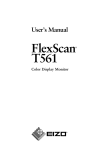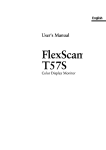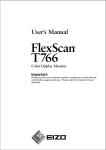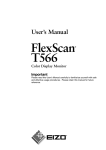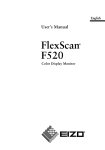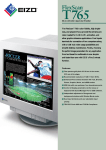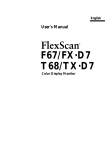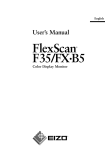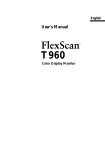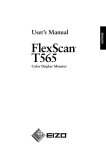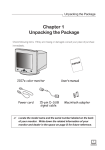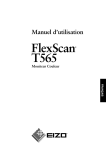Download FlexScan T761/T962 User's Manual
Transcript
User’s Manual Color Display Monitor SAFETY SYMBOLS This manual uses the safety symbols below. They denote critical information. Please read them carefully. WARNING Failure to abide by the information in a WARNING may result in serious injury and can be life threatening. CAUTION Failure to abide by the information in a CAUTION may result in moderate injury and/or property or product damage. Indicates a prohibited action. Indicates to ground for safety. Copyright© 2000 by EIZO NANAO CORPORATION. All rights reserved. No part of this manual may be reproduced, stored in a retrieval system, or transmitted, in any form or by any means, electronic, mechanical, or otherwise, without the prior written permission of Eizo Nanao Corporation. Eizo Nanao Corporation is under no obligation to hold any submitted material or information confidential unless prior arrangements are made pursuant to Eizo Nanao Corporation's receipt of said information. Although every effort has been made to ensure that this manual provides up-to-date information, please note that EIZO monitor specifications are subject to change without notice. ENERGY STAR is a U.S. registered mark. Apple and Macintosh are registered trademarks of Apple Computer, Inc. VGA is a registered trademark of International Business Machines Corporation. DPMS is a trademark and VESA is a registered trademark of Video Electronics Standards Association. Windows is a registered trademark of Microsoft Corporation. ScreenManager, PowerManager, QuickSet and i·Sound are trademarks of Eizo Nanao Corporation. FlexScan, SuperErgoCoat and EIZO are registered trademarks of Eizo Nanao Corporation. As an ENERGY STAR® Partner, Eizo Nanao Corporation has determined that this product meets the ENERGY STAR guidelines for energy efficiency. 2 CONTENTS PRECAUTIONS ............................................................................. 4 1. INTRODUCTION ............................................................................ 9 2. ENGLISH 1-1. Features ....................................................................................................... 9 1-2. Package Contents ........................................................................................ 9 1-3. Controls & Connectors ................................................................................ 10 INSTALLATION ........................................................................... 11 2-1. Connecting the monitor to the PC ............................................................... 11 2-2. Getting Ready for Operation ....................................................................... 13 3. SCREEN ADJUSTMENT ............................................................ 14 3-1. How to use the ScreenManager .................................................................. 14 3-2. Adjustments and Settings ........................................................................... 15 3-3. Special Function ......................................................................................... 22 4. CONNECTING TWO PCs TO THE MONITOR .............................. 23 5. MAKING USE OF USB (Universal Serial Bus) .......................... 24 6. TROUBLESHOOTING ................................................................. 28 7. CLEANING ................................................................................... 33 8. SPECIFICATIONS ....................................................................... 34 9. GLOSSARY.................................................................................. 38 10. INDEX .......................................................................................... 40 CONTENTS 3 PRECAUTIONS IMPORTANT! • This product has been adjusted specifically for use in the region to which it was originally shipped. The performance of the product, (i.e. picture geometry, picture positioning and color convergence and purity in the case of color monitors) is optimally adjusted to the earth’s magnetic field of the specific destination. If operated outside the region to which it was originally shipped, the product may not perform as stated in the specifications. • To ensure personal safety and proper maintenance. Please read this section and the caution statements on the monitor (refer to the figure below). [Location of the Caution Statements] The equipment must be connected to a grounded main outlet. Jordet stikkontakt skal benyttes når apparatet tilkobles datanett. Apparaten skall anslutas till jordat nätuttag. WARNING • If the monitor begins to emit smoke, smells like something is burning, or makes strange noises, disconnect all power connections immediately and contact your dealer for advice. Attempting to use a malfunctioning monitor can be dangerous. • Do not dismantle the cabinet or modify the monitor. Dismantling the cabinet or modifying the monitor may result in electric shock or burn. • Refer all servicing to qualified service personnel. Do not attempt to service this product yourself as opening or removing covers may expose you to dangerous voltage or other hazards. 4 PRECAUTIONS WARNING ENGLISH • Keep small objects away from the monitor. Small objects may accidentally fall through the ventilation slots into the cabinet, leading to fire, shock, or equipment damage. • Keep liquids away from the monitor. Spillage into the cabinet may result in fire, electric shock, or equipment damage. If an object or liquid falls/spills into the cabinet, unplug the monitor immediately. Have the unit checked by a qualified service engineer before using it again. • Place the monitor on a strong, stable surface. A unit placed on an inadequate surface may fall, resulting in injury or equipment damage. If the monitor falls, disconnect the power immediately and have the unit checked by a qualified service engineer before using it again. Using a monitor after it has been dropped may result in fire or electric shock. OK • Set the monitor in an appropriate location. * Do not install in a dusty or humid environment. * Do not place in a location where steam can have direct contact with the screen. * Do not place near heat generating devices or a humidifier. • Keep the plastic packing bags away from children and infants. Plastic bags can be dangerous. To avoid danger of suffocation, keep the bag away from babies and children. • Keep power terminal covers for the optional i·Sound™ sound unit away from children and infants. Children and infants may accidentally swallow the covers and choke. If swallowed, consult a doctor immediately. PRECAUTIONS 5 WARNING • Use the enclosed power cord. If using the power cord other than the enclosed one, use the following cord. [USA and Canada] Use a UL LISTED/CSA LABELED or CERTIFIED power cord set meeting the following specifications. * Rating: min. 125 V, 10 A * Length: max. 2.0 m * Plug type: NEMA 5-15P, Parallel blade, Grounding type, 125 V, 10 A * Type: SVT [Europe] Use a proper European standard approved power cord meeting the following specifications. * Rating: min. 250 V, 10 A * Length: max. 2.0 m * Type: H05VV-F 3G 1 mm2 Use a plug type approved by the country where you reside. Failure to do so may cause fire or electric shock. • To disconnect the power cord, grasp the plug firmly and pull. Never tug on the cord, doing so may cause damage and could result in fire or electric shock • The equipment must be connected to a grounded main outlet. • Use the correct voltage. * The monitor is designed for use with a specific voltage only. Connection to a different voltage may cause fire, electric shock, or other damage. * Do not overload your power circuit, as this may result in fire or electric shock. * For proper connections of the power cord, be certain to plug the power cord to the provided monitor connector and directly to a wall outlet. By not doing so may result in fire or electric shock. • Handle the power cord with care. * Do not place the cord underneath the monitor or other heavy objects. * Do not pull on the cord. * Do not attempt to repair a damaged cord. If the power cord becomes damaged, stop using it. Use of a damaged cord may result in fire or electric shock. • Never touch the plug and power cord if it begins to thunder. If it begins to thunder, do not touch the plug, power cord or cable. Touching them may result in electric shock. 6 PRECAUTIONS OK CAUTION ENGLISH • Handle with care when carrying the monitor. * Disconnect the power cord, signal cables and remove the optional i·Sound™ sound unit (if applicable). Moving the monitor with the cord attached or lifting it by the i·Sound™ sound unit is dangerous. It may result in injury or equipment damage. * Note that the monitor is heavier at the front than at the rear. Do not move it alone. Always work with another person. * The screen is optically coated to reduce glare. Keep hard objects (such as buttons, tiepins, and other clothing accessories) away from the screen surface to prevent scratches. OK • Do not block the ventilation slots on the cabinet. * Do not place books or any other papers on the ventilation slots. * Do not install the monitor in a closed space. * Do not use the monitor laying down or upside down. * Do not remove the tilt-swivel stand. Using the monitor in this way block the ventilation slots and prevents proper airflow, leading to fire or other damage. • Do not sit on the cabinet or place any heavy objects on the cabinet. A unit with heavy objects on it may fall or be damaged and result in injury. • When adjusting the viewing angle of the monitor, do not do so by handling i·Sound™ sound unit (if applicable). Adjusting the monitor in this way may break the unit or cause bodily injury. • At the end of the day or if you plan to leave the monitor unused for an extended period, after turning off the power switch disconnect the power cord from the wall socket so that no power connections are made. PRECAUTIONS 7 CAUTION • Do not touch the plug with wet hands. Touching the plug with wet hands is dangerous and can cause electrical shock. • Use an easily accessible power outlet. This will ensure that you can disconnect the power quickly in case of a problem. • Unplug the monitor before cleaning it. Cleaning the monitor while it is plugged into a power outlet may result in electric shock. • Never use thinner, benzene, alcohol (ethanol, methanol, or isopropyl alcohol), abrasive cleaners, or other strong solvents, as these may cause damage to the cabinet or CRT. • Periodically clean the area around the plug. Buildup of dust, water, or oil on the plug may result in fire. 8 PRECAUTIONS 1. INTRODUCTION Thank you very much for choosing an EIZO Color Display Monitor. 1-1. Features ENGLISH • Fully flat screen CRT. • T761 Horizontal scanning frequency of 30-115 kHz Vertical scanning frequency of 50-160 Hz T962 Horizontal scanning frequency of 30-130 kHz Vertical scanning frequency of 50-160 Hz • Fine contrast function with a wider margin provides for a more brightly contrasted picture. • Dual inputs with individual color configuration. • USB (Universal Serial Bus) hub supported. 1-2. Package Contents Please contact your local dealer for assistance if any of the listed items are missing or damaged. • Monitor • Signal Cable (MD-C87/MD-C100) • Power Cord • EIZO CRT Utility Disk • User’s Manual • Quick Reference • Warranty Registration Card • Please retain the packing materials for future transference. 1. INTRODUCTION 9 1-3. Controls & Connectors Front (1) ScreenManager™ (2) USB Port with a drop down access lid Downstream port x 1 (3) BNC/D-SUB Selection Button (4) AUTO-SIZING Button (5) Power Terminal Covers for the Optional i·Sound Sound Unit. (Bottom side) (6) QuickSet™ Control Pad (Hereinafter “Control Pad”) (7) Power Indicator (1) (2) (3) (8) Indicated color Power-on status Green Power is on (Normal mode) Flashing Green Power save mode 1 Advance notice of monitor’s off timer (See page 20) Yellow Power save mode 2 Flashing Yellow Power save mode with monitor’s off timer (See page 20) (4) (5) (6) (7) (8) Power Switch Rear (9) (10) (11) (12) (14) (9) (10) (11) (13) (12) 10 1. INTRODUCTION Power Connector D-Sub Mini 15 Pin Input Connector BNC Input Connector Termination Switch Allows multiple monitors to be chained together (Default termination is 75 Ω) (13) Maintenance Port (14) USB Port Downstream port x 3 Upstream port x 1 2. INSTALLATION 2-1. Connecting the monitor to the PC 1. Plug the signal cable into the connector at the rear of the monitor and the other end of the cable into the video connector on the PC. After connecting, secure the connection with the screw-in fasteners. • Standard graphics board Video Output Connector D-Sub mini 15 pin Standard graphics board Signal Cable (Enclosed) • Macintosh Video Output Connector D-Sub mini 15 pin Macintosh (Blue & White) Signal Cable (Enclosed) Video Output Connector D-Sub 15 pin Macintosh Macintosh Adapter (Optional) Please consult EIZO dealer. 2. INSTALLATION 11 ENGLISH • Be sure that the power switches of both of the PC and the monitor are OFF. 2. Plug the power cord into the power connector at the rear of the monitor. Then plug the other end of the cord into a power outlet. WARNING • The equipment must be connected to a grounded main outlet. • Use the enclosed power cord. If using the power cord other than the enclosed one, use the following cord. [USA and Canada] Use a UL LISTED/CSA LABELED or CERTIFIED power cord set meeting the following specifications: * Rating: min. 125 V, 10 A * Length: max.2.0 m * Type: SVT * Plug type: NEMA 5-15P, Parallel blade, Grounding type, 125 V, 10 A [Europe] Use a proper European standard approved power cord meeting the following specifications: * Rating: min. 250 V, 10 A * Length: max. 2.0 m * Type: H05VV-F 3G 1 mm2 Use a plug type approved by the country where you reside. Failure to do so may cause fire or electric shock. 3. Turn on the monitor first, then the PC. The monitor’s power indicator will light up (green). The monitor will warm up briefly, then display an image. Whenever finishing your operation, turn off the PC and the monitor. (If an image does not appear, make sure that all connections have been made properly. Refer to the “TROUBLE SHOOTING” (See page 28) for additional advice.) • Generally, for maximum viewing comfort, position the monitor slightly below eye level. Staring at the monitor for prolonged periods can cause eye strain. Be sure to take adequate rests. (A 10-minute rest period each hour is suggested.) 12 2. INSTALLATION 2-2. Getting Ready for Operation Try each setting procedure if necessary in the following cases. ENGLISH The display image size and / or position is incorrect Press the AUTO-SIZING button on the front panel. The AUTO-SIZING function centers the displayed image, aligning the image’s borders with respect to the monitor frame. In general, press the AUTO-SIZING button whenever changing the graphics board or the resolution p.39) , or when image size and/or position is incorrect. If further adjustment is required, adjust the picture size/ position as desired using the ScreenManager (See page 14). • A solid-color screen (i.e. red, green, blue) may appear briefly after pressing the AUTO-SIZING button. This is not a malfunction. • When the timing of the computer is same as the preset timing or has been recognized before, the following message will appear and remain on the screen for 5 seconds. While the message is on the screen, press the AUTO-SIZING button again to automatically adjust the screen position. If not wishing to adjust the screen, do not press the button again or press the control pad. The message will disappear. The display area is too large or too small Readjust the preferred refresh rates in accordance with the following look-up-table. Refer to the PC or graphics board manuals on how to change the refresh rates. [The maximum (non-interlaced) vertical refresh rates for these models] Maximum Vertical Refresh rate (Hz) 640x480 800x600 T761 160 160 1024x768 1280x1024 1600x1200 1600x1280 1920x1440 2048x1536 142 107 92 86 76 - T962 160 160 160 121 104 97 86 80 Using the monitor with Windows® 95/98/2000 A monitor information file is contained in the EIZO CRT Utility Disk included with the monitor. It includes all the required information for best operation with Windows 95/98/ 2000. Please install the enclosed utility and select your model name from the monitor list in Windows 95/98/2000. For installation procedure, please read the readme.txt file in the utility disk. 2. INSTALLATION 13 3. SCREEN ADJUSTMENT • Allow the monitor to stabilize for at least 30 minutes before making image adjustments. 3-1. How to use the ScreenManager Up Use the control pad on the front panel. The control pad can be pressed in 5 directions, “Enter”, “Up”, “Down”, “Left” and “Right”. Left Enter Right Down 1. Entering the ScreenManager Display the ScreenManager “Main menu” by pressing the “Enter” of the control pad. Main menu displays the current connector type and frequency of the input signal. Main menu Æ 2. Making Adjustments and Settings (1) (2) (3) (4) 3. Select the desired icon by using “Up”, “Down”, “Left” and “Right” keys. Press the “Enter” key to display each adjustment/setting menu or “Sub menu”. Make the required adjustments/settings by using the control pad. To save the adjustments/settings and return to the Main menu, press the “Enter” key. Exiting the ScreenManager To exit the ScreenManager, select the “Exit from the “Main menu” and press the Enter key. Pushing the down arrow key twice goes to the “Exit” position instantly. • Leaving the ScreenManager idle for 45 seconds or more will turn the adjustment off automatically without saving. 14 3. SCREEN ADJUSTMENT 3-2. Adjustments and Settings Main menu Sub menu Adjustments and Settings See page — Screen contrast and brightness* — Size — Screen size — Position — Screen position — Screen Side Pin. Side pin balance — Trapezoidal Distortion — Tilt Inclination Uniformity Convergence Uniformity Color p. 16 p.38) p.38) — — Fine Contrast To brighten the photo, picture image or movie. p. 17 Signal Filter 1 To decrease the slightly shadowed images or characters. p. 17 Signal Filter 2 To decrease the vertical bars. p. 17 “Standard” Color Temperature To set the color temperature p.38). p. 18 Color Correction To eliminate disparities in color temperature and brightness due to an irregular video signal output. p. 18 To adjust each color, (Red, Green and Blue). p. 19 “Custom” Others — p.39) Convergence Moiré Reduction Moiré ENGLISH Contrast PowerManager To set the power save. (With PC’s power saving system) p. 20 Off Timer To set the power save. (With Monitor’s Off timer) p. 20 Degauss To degauss P.38). p. 21 Button Setting To customize the button function. p. 21 Beep To set beeper on/off. p. 21 Menu Position To adjust the menu position of the ScreenManager. p. 21 Language To select the preferred language to use. p. 22 Input Priority To select the priority input signal. p. 23 Reset To return to the factory default setting. p. 22 * When a black background (e.g. DOS text) is used, setting the brightness at its maximum is recommended because a dark setting will result in eye strain due to high character contrast. 3. SCREEN ADJUSTMENT 15 < Screen > • To adjust the uniformity Reduce color uniformity errors at the edges of the screen caused by interference from the geomagnetic field. <T761> < Uniformity > Adjust the uniformity as desired by using the control pad. <T962> < Uniformity > < Standard> Select the direction the monitor is facing. Select from the N, NE, E, SE, S, SW, W, NW and Center (no correction). The “point” may be different depending on the environment. Select the “Point” that the maximal brightness and whiteness is uniformed. * If the uniformity is corrected, continue on to (4). * If some color patches remain in the corners after the adjustment, continue on to (2). (2) < Top/Bottom > Adjust the top/bottom uniformity. (1) Top Bottom (3) < Top corner > < Bottom corner > Adjust the uniformity of the for 4 edges of the screen. * Be sure to adjust the “Top corner” first, then adjust the “Bottom corner”. Top corner: Control pad “left/right”...... Left upper Control pad “up/down”..... Right upper Bottom corner: Control pad “left/right”....... Left lower Control pad “up/down”..... Right lower 16 3. SCREEN ADJUSTMENT (4) < Save > Select “Save” and the press the enter button. (If the settings are not saved, all adjustments will be lost.) * <Reset> Resets the uniformity function to the factory default setting. • To brighten the photo, picture image or movie • To decrease a slightly shadowed image or characters This function can decrease images or characters with slight shadows on the right side when the characteristics of the graphics board do not match those of the monitor. < Signal Filter 1 > Select from mode 1 or 2 in the Signal Filter 1 menu, whichever displays the image better. • To decrease the vertical bars This function can decrease vertical bars and brightness lines on the right side of images or characters. <Signal Filter 2> Adjust the percentage by using the control pad until the images seem clear in the Signal Filter 2 menu. 3. SCREEN ADJUSTMENT 17 ENGLISH < Fine Contrast > Select “Text”, “Picture” or “Movie” for preferred mode as desired by using the control pad. * Available to adjust the preferred “contrast and brightness” after setting. * Select “Movie” when the entire screen is dark. * Select “Text Mode” to display the text on word processor or calculating software. * The AUTO-SIZING button can be customized to activate this function easily. (Textà Pictureà Movieà Text...) (See page 21). < Color > • To set the color temperature Temperature can be set from 4,000 K to 10,000 K, in 500 K increments. (Including the 9,300 K default setting.) < Temperature> Set the preferred “Color temperature”. “Standard” mode • To eliminate disparities in color temperature and brightness due to an irregular video signal output Color Correction corrects irregular video signal output levels to eliminate disparities in color temperature and brightness. When two PCs are connected to one monitor or to several monitors and this function is utilized, all monitors will display nearly uniform color temperature and brightness. (1) Open a www browser and the Pattern.html in the EIZO CRT utility disk. If this file is not available, open a window on the Windows or Macintosh OS for alternative use. Refer to the picture on the left. (2) “Standard” mode White window pattern with a size that is more than 1/5 and less than 1/2 of the whole display area. Set the background to black BN C /A UTO D- SUB < Color Correction > Select “OK”. All other adjustments are off during the correction. (The operation takes about 20 to 30 seconds. Do not change the “Pattern” during the correction.) When color correction is complete, the result is displayed. • Successful • Unsuccessful When unsuccessful, no adjustment to the screen is made. Press any button on the front panel to turn this message menu off and return to the sub menu. 18 3. SCREEN ADJUSTMENT • To adjust each color , (Red, Green and Blue) Adjust the “Cutoff”p.38) and “Gain”p.38) for color tone. (1) First, set the monitor to maximum contrast and brightness. (2) “Custom” mode < Temperature> Set the color temperature that is close to the desired color. (3) < Cut off > Adjust each color to become a uniform black level by using the “Cutoff” function. (4) < Gain > Adjust each color to the desired white level by using the “Gain” function. (5) < Save > Select “Save” and then press the Enter key. The adjustment data will be lost, if the monitor is turned off without saving changes. * The values shown in percentages (%) for both the Cutoff and Gain are available only as a reference tool. 3. SCREEN ADJUSTMENT 19 ENGLISH * In the following cases, color correction will be unsuccessful. • When the input signal level is lower than 0.5 Vp-p or higher than 1.0 Vp-p. • When window size is not appropriate. • When the termination switch on the rear of the monitor is set to“∞” and connecting the monitor with a BNC cable. * Color correction automatically corrects color temperature from 4000 K to 10000 K at 1 time. Therefore, proper color displays in the every color temperature after correction. * Every time the PC (graphics board) and input signal change, execute color correction. < Others > • To set the power save There are two power save settings choose the setting which matches your environment. • Do your part to conserve energy, turn off the monitor when you are finished using it. Complete energy use can only be accomplished by disconnecting the monitor’s power supply cord from the plug receptacle. 1. With PC’s power saving system (VESA DPMS p.39)) The monitor detects the signal from the PC and executes the power saving accordingly, as shown in the table below. < PowerManager > Select “On”. Operate the mouse or keyboard to return to a normal screen. [Power saving system] PC Signal ON Screen Operation LED Green STAND-BY SUSPEND OFF Blank screen Green Power save (Mode 1) Flashing green Power save (Mode 2) Yellow Power consumption T761 130 W (normal) T962 160 W (normal) 80% of normal Less than 10 W Less than 3 W 2. With Monitor’s off timer system Without the PC’s power saving system, the off timer allows the monitor to Enter a power save mode after a predetermined amount of time has lapsed. < Off Timer > Select “Enable” and press the left/right keys on the control pad to set the “On period”. (1 to 23 hours) Press any direction of the control pad or to turn the power off then on again to return to a normal screen. [Power saving system] Time On period (1-23) Power consumption T761 130 W (normal) T962 160 W (normal) Last 15 min. in T761 130 W (normal) “On period” Advance notice* Flashing green T962 160 W (normal) “On period” expired Power save mode Flashing yellow Less than 3 W * To delay entering the power save mode, press any direction of the control pad during the advance notice mode. 20 Screen Operation 3. SCREEN ADJUSTMENT LED Green • To degauss the monitor • To customize the button function (Auto sizing or Fine Contrast) < Button Setting > Select “Auto Sizing”(Auto sizing function <See page 13>) or “Fine Contrast” (Brighten the photo, picture image or movie <See page 17>). • To set beeper on/off < Beep > Select the beep “On" or "Off" Short beep • ScreenManager item selected. • ScreenManager parameter adjusted to minimum or maximum limit. • BNC/D-Sub selection button pressed. Long beep • AUTO-SIZING button pressed. • ScreenManager data-save executed. • When the “Color Correction” function of the color adjustment is successfully executed. Four short beeps • The signal cable of the PC is not properly connected to the monitor. • Monitor received unsupported signal frequency. • When the “Color Correction” function of the color adjustment is unsuccessfully executed. Every fifteen seconds • The last 15 min. in “On period”. • To adjust the menu position of the ScreenManager < Menu Position > Adjust the menu position as desired by using the control pad. 3. SCREEN ADJUSTMENT 21 ENGLISH < Degauss > Press the center of the control pad. * The degauss circuitry takes about 30 minutes to regain maximum power following degaussing. • To select the preferred language to use < Language > Six languages are available to choose from: English, German, French, Spanish, Italian and Swedish. The ScreenManager’s messages will appear in the selected language. • To return to the factory default setting < Reset > Select “Reset”. * “ Uniformity” in the “Screen” menu dose not return to the factory default setting (See page 16). Default settings are as follows. Contrast Fine Contrast Signal Filter 2 PowerManager Button Setting Language 100% / 50% Text Mode 100% On Auto Sizing English Moiré Reduction Signal Filter 1 Color Off Timer Beep Input priority 0% Mode 1 Standard /9,300K Disable On Auto (D-SUB) 3-3. Special Function Shortcut Keys The brightness and contrast can be adjusted by pressing the “Up”, “Down”, “Left” and “Right” keys of the control pad directly. Press the “Enter” of the control pad to save and exit the settings after the adjustment. Adjustment Lock Use the “Adjustment Lock” function, to prevent any accidental changes. Locked function Unlocked function • Adjustments and settings in the ScreenManager. • AUTO-SIZING button. • Adjustment of contrast and brightness by the shortcut keys. • BNC/D-Sub Selection button. • To lock Press on the AUTO-SIZING button while switching on the monitor’s power. • To unlock Switch off the monitor’s power, then hold down the AUTO-SIZING button once again and turn the power back on. 22 3. SCREEN ADJUSTMENT 4. CONNECTING TWO PCs TO THE MONITOR Two PCs can be connected to the monitor through the BNC/D-Sub input connections on the back of the monitor. (Example) Apple Macintosh (Blue & White) ENGLISH à Standard graphics board MD-C53A (Optional) Selecting the active input The BNC/D-Sub selection button on the front panel can be used to select either the BNC or D-Sub connection as the active input. Every time the button is pressed, the input changes. The priority input signal This function is used to select which PC will have priority to control the monitor when utilizing two PCs. In the following cases, the signal given preference will be displayed automatically. • When the monitor is turned on. • Once a priority is selected in the “Input Priority” function, whenever a change of signal is detected at the selected input, the monitor will switch the input to that signal. < Input Priority> < Others > menu / Select “Auto” with the left/right arrow keys and select the desired input signal mode. * “Auto”: If only one PC is connected to the monitor, it automatically detects and displays the signal from that PC. * “Manual”: Select the active input by pressing the BNC/D-SUB selection button. Adjustment data can be saved for both PCs The following adjustment and setting data can be saved for each input signal (BNC/D-Sub). Contrast/Brightness Fine Contrast Signal Filter 1 Signal Filter 2 Color Mode “Standard” Temperature Color Mode “Standard” Color Correction Color Mode “Custom” p.15 p.17 p.17 p.17 p.18 p.18 p.19 4. CONNECTING TWO PCs TO THE MONITOR 23 5. MAKING USE OF USB (Universal Serial Bus) This monitor provides a hub which supports the USB standard. When connecting to a USB compliant PC or another hub, the monitor functions as a hub to which the USB compliant peripherals can be easily connected. As an added advantage, the monitor can be controlled from a PC with a mouse or keyboard when utilizing the enclosed utility software “ScreenManager Pro for USB” (Windows 98/2000). Required system environment • PC equipped with USB ports or another USB hub connected to the USB compliant PC • Windows 98/2000 // Mac OS 8.5.1 or later • USB cable (Sold separately) • The USB hub function may not work properly depending on the PC, OS or peripherals. Please consult the manufacturer of each device about the USB support. • When the monitor is not on, the peripherals connected to the downstream ports will not operate. • Even if the monitor is in a power saving mode, the devices connected to the monitor’s USB ports (both the upstream and the downstream) will function. Connecting to the USB HUB (Setting up the USB function) • Do not connect the downstream port of the monitor to any peripherals until finishing the USB function. • The followings are procedures for the Windows 98 Second Edition/2000 and Mac OS. 1. Connect the monitor to the PC with the signal cable (See page 11) first, then turn on the PC. 2. Connect the upstream port of the monitor to the downstream port of the USB compliant PC or another hub by using the USB cable . USB CABLE Upstream port: Connect the USB compliant PC or another hub using the USB cable. After connecting the USB cable, the USB function can be set up automatically. 24 5. MAKING USE OF USB (Universal Serial Bus) • Please follow the instructions below for proper installation. [For Windows 2000] 1. Click the “Start” button and open the “Control Panel” from “Settings”. 2. Select “System” from the “Control Panel” to open the “System Properties”. 3. Select “Device Manager” from “Hardware” in the “System Properties” and confirm that the following icon is found. - “EIZO HID Monitor Controls” appears under “Human Interface Devices”. [For Mac OS ] 1. Select the “Apple System Profiler” from the Apple menu. 2. Select the “Devices and Volumes” in the “Apple System Profiler” and confirm that the following icon is found. - “EIZO USB HID Monitor” appears under “USB”-”Hub”. 3. After setting up, the monitor’s USB hub is available for connecting USB compliant peripherals to the downstream ports of the monitor. (Connection example) Scanner USB Cable Printer Monitor Digital Camera PC Keyboard Mouse 5. MAKING USE OF USB (Universal Serial Bus) 25 ENGLISH [For Windows 98 Second Edition] 1. Click the “Start” button and open the “Control Panel” from “Settings”. 2. Select “System” from the “Control Panel” to open the “System Properties”. 3. Select “Device Manager” in the “System Properties” and confirm that the following icon is found. - “EIZO USB HID Monitor” appears under “Human Interface Devices”. <Front port> Downstream connector <Rear port> Downstream ports: Connect the cables from USB compliant peripherals such as a mouse, keyboard, etc. Troubleshooting 1. USB function cannot be setup. Check that the USB cable is correctly connected. Check that the PC and OS are USB compliant. (Please consult the manufacturer of each device about USB support.) When using the Windows 98/2000, check the BIOS setting of the PC for the USB. (Refer to the PC manual for details.) 2. PC does not operate. / The peripherals connected to the downstream ports do not operate. Check that the USB cable is correctly connected. Connect the peripherals to other downstream ports. If the problem is solved by doing this, contact an EIZO dealer. Try the following: • Restart the PC. • Connect the peripherals to the PC directly. If this solves the problem, contact an EIZO dealer. The power button of the Apple keyboard does not operate if it is connected to the EIZO USB Hub. To function the power button of the Apple keyboard, connect the keyboard directly to the PC. Refer to the PC manual for details. 26 5. MAKING USE OF USB (Universal Serial Bus) ScreenManager Pro for USB (For Windows 98/2000) • This program is only available for Windows 98/2000 and is not available for the Mac OS. • When using this program, the monitor must be connected to a USB compliant PC (OS) or another hub with the USB cable (Sold separately). For instructions, please refer to the previous page. (See page 24) To set up the “ScreenManager Pro for USB”, execute the “setup.exe” program in the “App” directory of the “EIZO CRT Utility Disk” and follow the procedure displayed on the screen. To verify that the setup is completed, click “Advanced...” on the “Settings” tab in “Display Properties” and see if the “EIZO” tab is added. Refer to the Help menu in the program for the details. For more information about ScreenManager Pro for USB setup, refer to the readme.txt file. 5. MAKING USE OF USB (Universal Serial Bus) 27 ENGLISH The utility software “ScreenManager Pro for USB” is included in the enclosed EIZO Utility Disk. It is used for controlling the EIZO monitor from a PC using a mouse or keyboard. It allows control of the screen adjustment (size, position, distortion, color, contrast, moiré, etc.) by using a mouse or keyboard. Furthermore, the adjusted screen data and the color data can be stored as data files in the PC. 6. TROUBLESHOOTING If a problem persists even after applying the suggested remedies, contact an EIZO dealer. Problems 1. No picture • Indicator status: Off • Indicator status: Green • Indicator status: Flashing Green / Yellow • Indicator status: Flashing Yellow 2. Following messages appear. • “No signal detected” error message appears. • “Out of range” error message appears. Whenever an error signal message appears, the signal frequency will be displayed in red. (Example) 28 6. TROUBLESHOOTING Points to check with possible solutions Check that the power cord is correctly connected. If the problem persists, turn off the monitor power for a few minutes, then turn it back on and try again. Check the “Contrast and Brightness” function in the ScreenManager “Main” menu. Try pressing a key on the keyboard, or clicking the mouse. (p. 20) Try pressing the AUTO-SIZING button or control pad or turn the monitor off and then on.(p. 20) These messages appear when the signal is not inputted correctly, even if the monitor functions properly. Error messages shown below will remain on the screen for 30 seconds. When the image is displayed correctly after a short time, it is not a monitor’s problem. (Some PC does not output the signal soon after powering on.) Check that the PC is turned ON. Check that the signal cable is properly connected to the PC or graphics board. Switch the signal input by pressing the BNC/D-Sub selection button on the front control panel. Use the graphics board’s utility software to change the frequency setting. (Refer to the manual of the graphics board.) Problems Points to check with possible solutions Check that the signal cable is properly connected to the PC or graphics board. The monitor may be located close to a device that is generating a magnetic field. Such devices include speakers (other than the EIZO optional i·Sound speaker), electric motors, high-voltage cables, and other monitors. It may be solved by turning off or moving the interfering device, or by relocating the monitor. Use of the “Moiré” adjustment may cause a slight vibration. To eliminate the vibration, set the adjustment level to lower percentage or 0%. (p. 15) If the volume level of the EIZO optional i·Sound speaker is too high, it may, in some cases, cause a slight vibration. To eliminate, turn down the volume of the speaker. 4. The image is flickering. Flicker will occur with interlaced scanning, or noninterlaced scanning with a low refresh rate. All EIZO monitors are capable of reproducing high refresh rates for non-interlaced scanning. If a problem occurs when using a non-interlaced signal, try adjusting the graphics board to increase the refresh rate (if possible). Refer to the graphics board manual for information. 5. Moiré patterns appear. Reduce the moiré using the “Moiré” function in the ScreenManager “Screen” menu. (p. 15) Change the horizontal and vertical size of the display area. Change the selected desktop or wallpaper pattern to any solid color pattern. For detailed information on how to change these patterns, refer to the PC and operating system manual. 6. The characters and images have a slight shadow on their right side. Change the mode of “Signal Filter 1” function in the ScreenManager “Screen” menu. (p. 17) Change the refresh rate. Refer to the PC and graphics board manual for information. 6. TROUBLESHOOTING 29 ENGLISH 3. The image vibrates on the screen. Problems Points to check with possible solutions 7. The characters and images have several vertical bars on their right side. Adjust to decrease the vertical bars at the “Signal Filter 2” function in the ScreenManager “Screen” menu. (p. 17) 8. The entire screen appears too dark or bright. Adjust the “Contrast and Brightness” function in the ScreenManager “Main” menu. (p. 15) Some signal timing can be the cause of this problem. To correct this, turn off the monitor, then hold down the “down” arrow key while turning on the monitor again. This will change the signal timing and brighten the screen. If the above operation is repeated, the screen becomes dark again. 9. Color is abnormal When the monitor is not fully warmed up, the screen may look slightly colored, e.g. bluish or reddish. This phenomenon is due to the unstableness of the electron gun during its warm-up period. Wait for about 30 minutes until the monitor stabilizes in order to gain its proper color. Adjust the “Degauss” function in the ScreenManager “Others” menu. (p. 21) Return the factory default setting by using “Reset” function in the ScreenManager “Others” menu. Note that all the ScreenManager parameters will be returned to the factory default setting. (p. 22) Adjust the “uniformity” in the ScreenManager's “Screen” menu. (p. 16) Try adjusting the “Convergence” in the ScreenManager “Screen” menu. (p. 15) The “convergence” function adjusts the entire screen. It is not possible to limit adjustment to specific screen areas. The termination switch on the rear of the monitor should be set to 75 Ω position (default) for connection to a single monitor. • The entire screen appears bluish or reddish. • Color purity is not uniform. • Misconvergence of colors(red, green, blue). 30 6. TROUBLESHOOTING Problems Points to check with possible solutions Color Correction does not work properly when the input signal level is lower than 0.5 Vp-p or higher than 1.0 Vp-p. The size of the window may not be appropriate. Use the Pattern.html file for setup or adjust the size of the window. The termination switch on the rear of the monitor should be set to 75 Ω position (default) when connecting the monitor with BNC cable. 11. AUTO-SIZING button does not work properly. The Auto sizing function is intended for use on the Macintosh and on AT-compatible PC running Windows. It may not work properly if either of the following cases. • You are running an AT-compatible PC on MS-DOS (Not windows). • The background color for the “wall paper” or “desktop”pattern is set to black. Some signals from graphics board may not function properly. 12. ScreenManager/AUTOSIZING button does not operate. The Adjustment Lock is probably on. To unlock: Turn off the monitor power, then hold down the AUTO-SIZING button once again and turn the power back on. (p. 22) The AUTO-SIZING function may be set “Fine Contrast” in the “Button Setting”. Change the setting to “Auto Sizing”. (p. 21) 13. Two horizontal hairlines are visible on the screen. These are damper wires. [ About Damper wires] Damper wires are used to support the CRT’s aperture grille, and are visible as thin dark lines across the screen. All EIZO aperture grille type CRTs include two such horizontal wires. The aperture grille itself is a grid of taut metal filaments that spans the entire screen from top to bottom. 6. TROUBLESHOOTING 31 ENGLISH 10. Color correction does not work properly. (p.18) Problems 14. Faint black vertical lines are visible on the screen. Points to check with possible solutions The aperture grille may be misaligned. Shock or vibration during transport may, in some cases, cause the aperture grille to fall out of alignment. The problem will appear as one or more faint black lines across the screen. If this problem occurs, it may be solved by: 1. Degaussing the screen. 2. Lightly tapping (do not hit) the side of the monitor. If neither of these methods works, try executing the following procedure. 1. Display a bright white field over the area where the black line(s) appear, with a black field over the unaffected areas. (Do this by opening a bright-white window on top of a black desktop or wallpaper background. Position the window so that it just covers the area of misalignment.) 2. Set brightness and contrast to maximum values, and keep the display ON until the problem is corrected. Try tapping the side of the display lightly to help expedite realignment. The white field will heat up the misaligned area of the grille, returning it to proper alignment. • For problems with the USB function, refer to the troubleshooting on page 26. 32 6. TROUBLESHOOTING 7. CLEANING Periodic cleaning is recommended to keep the monitor looking new and to prolong its operational lifetime. Clean the cabinet and CRT areas as follows: ENGLISH WARNING • Keep liquids away from the monitor. Spillage into the cabinet may result in fire, electric shock, or equipment damage. If an object or liquid falls/spills into the cabinet, unplug the monitor immediately. Have the unit checked by a qualified service engineer before using it again. Using the monitor in this condition could cause serious injury or equipment damage. CAUTION • To ensure safety, always unplug the monitor before cleaning it. Failure to do so may result in electric shock. • Periodically clean the area around the plug. Buildup of dust, water, or oil on the plug may result in fire. • Never use thinner, benzene, alcohol (ethanol, methanol, or isopropyl alcohol), abrasive cleaners, or other strong solvents, as these may cause damage to the cabinet or CRT. Cabinet To remove stains, wipe the cabinet with a soft, lightly moistened cloth using a mild detergent. Do not spray wax or cleaner directly onto the cabinet. CRT Surface The CRT surface can be cleaned with a soft cloth, such as cotton or lens paper. If necessary, stubborn stains can be removed by moistening part of a cloth with water to enhance its cleaning power. 7. CLEANING 33 8. SPECIFICATIONS FlexScan T761 CRT CRT AG Pitch Scan Frequency Horizontal Vertical Recommended Resolution Max. Active Display Area* Power Supply Power Consumption Input Connector Input Signal Sync Video Signal registration Plug & Play Dimensions Weight Temperature Humidity Certifications and Standards 100-120 VAC 220-240 VAC USB specification USB standard USB Monitor Control Class Standard Communication speed Downstream power supply USB ports 50 cm (19 inch) class, 90° deflection Tension Mask with Anti- Reflective SuperErgoCoat® 0.24 mm (center) 0.25 mm (edge) 30 kHz- 115 kHz (Automatic) 50 Hz-160 Hz (Automatic) 1280 dots x 1024 lines 362 mm (H) x 271 mm (V) (14.3” (H) x 10.7” (V)) (Viewable image size: 452 mm (17.8”)) 100-120/220-240 VAC±10%, 50/60 Hz, 1.8 A/0.9 A Normal/Max.: 130 W/165 W** (**With EIZO optional speaker & USB attached) PowerManager Mode 1: Less than 10 W PowerManager Mode 2: Less than 3 W D-Sub mini 15-pin and BNC × 5 (Switchable) a) Separate, TTL, Positive/Negative b) Composite, TTL, Positive/Negative c) Sync on Green, 0.3 Vp-p, Negative Analog 0.7 Vp-p/75 Ω, Positive 20 signals (Factory preset 2 modes) VESA DDC 2B 452 mm (W) x 455 mm (H) x 478 mm (D) (17.8” (W) x 17.9” (H) x 18.8” (D)) 27.5 kg (60.7 lbs.) operating: 0°C to 35°C (32°F to 95°F) storage: -20°C to 60°C (-4°F to 140°F) 30% to 80% R.H. Non-condensing NRTL/C-TÜV, FCC-B, DHHS, TCO’99, EPA ENERGY STAR® Program CE, CB, TÜV Rheinland/GS, TCO’99, EPA ENERGY STAR® Program, TÜV Eco Circle 2000 Rev. 1.1 complied self-powered hub Rev. 1.0 complied 12 Mbps (full), 1.5 Mbps (low) 500 mA for each (Max.) Upstream port x 1, Downstream port x 4 * Display size can be set by the user through microprocessor control panel. The actual size displayed can be dependent on the graphics board or PC utilized. 34 8. SPECIFICATIONS FlexScan T962 CRT Horizontal Vertical Recommended Resolution Max. Active Display Area* Power Supply Power Consumption Input Connector Input Signal Sync Video Signal registration Plug & Play Dimensions Weight Temperature Humidity Certifications and Standards 100-120 VAC 220-240 VAC USB specification USB standard USB Monitor Control Class Standard Communication speed Downstream power supply USB ports ENGLISH CRT AG Pitch Scan Frequency 55 cm (21 inch) class, 90° deflection Tension Mask with Anti- Reflective SuperErgoCoat® 0.24 mm 30 kHz- 130 kHz (Automatic) 50 Hz-160 Hz (Automatic) 1600 dots x 1200 lines 400 mm (H) x 298 mm (V) (15.7” (H) x 11.7” (V)) (Viewable image size: 498 mm (19.6”)) 100-120/220-240 VAC±10%, 50/60 Hz, 2.2 A/1.0 A Normal/Max.: 160 W/200 W** (**With EIZO optional speaker & USB attached) PowerManager Mode 1: Less than 10 W PowerManager Mode 2: Less than 3 W D-Sub mini 15-pin and BNC × 5 (Switchable) a) Separate, TTL, Positive/Negative b) Composite, TTL, Positive/Negative c) Sync on Green, 0.3 Vp-p, Negative Analog 0.7 Vp-p/75 Ω, Positive 20 signals (Factory preset 2 modes) VESA DDC 2B 494 mm (W) x 486 mm (H) x 520 mm (D) (19.4” (W) x 19.1” (H) x 20.5” (D)) 36.0 kg (79.4 lbs.) operating: 0°C to 35°C (32°F to 95°F) storage: -20°C to 60°C (-4°F to 140°F) 30% to 80% R.H. Non-condensing NRTL/C-TÜV, FCC-B, DHHS, TCO’99, EPA ENERGY STAR® Program CE, CB, TÜV Rheinland/GS, TCO’99, EPA ENRTGY STAR® Program, TÜV Eco Circle 2000 Rev. 1.1 complied self-powered hub Rev. 1.0 complied 12 Mbps (full), 1.5 Mbps (low) 500 mA for each (Max.) Upstream port x 1, Downstream port x 4 * Display size can be set by the user through microprocessor control panel. The actual size displayed can be dependent on the graphics board or PC utilized. 8. SPECIFICATIONS 35 Preset Timing Frequencies fH(kHz) fV(Hz) 720 x 400 31.47 — 1280 x 1024 ¡ 1600 x 1200 T761 T962 Resolution VGA (text) ¡ ¡ VESA ¡ VESA — Video Signal Level Interlace Sync Polarity 70.09 Non H./Negative V./Positive 0.7 V(p-p)/75 Ω 91.15 85.02 Non H./Positive V./Positive 0.7 V(p-p)/75 Ω 106.25 85.00 Non H./Positive V./Positive 0.7 V(p-p)/75 Ω Dimensions FlexScan T761 mm (inches) 350 (13.8) 452 (17.8) 362 (14.3) 455 (17.9) 271 (10.7) 10° 4° 129.5 (5.1) φ306 (φ12.0) 47.5 (1.9) 75 (2.95) FRONT 478 (18.8) 45° 45° SIDE TOP FlexScan T962 mm (inches) 386.6 (14.5) 494 (19.5) 400 (15.8) 486 (19.1) 298 (11.7) 10° 4° 127 (5.0) φ306 (φ12.0) FRONT 36 8. SPECIFICATIONS 44.9 (1.8) 72.5 (2.9) 520 (20.5) SIDE 45° 45° TOP Pin Assignment * D-Sub mini 15 pin connector No. Signal No. Signal 8 Blue ground 9 No pin Green composite sync ENGLISH 1 Red Video 2 Green Video / 10 Ground 3 Blue video 11 (Shorted) 4 Ground 12 Data (SDA) 5 No pin 13 H. Sync / H/V Composite sync 6 Red gound 14 V. Sync 7 Green ground 15 Clock (SCL) * BNC Connector Connector H. Sync V. Sync Green Red Blue H. Sync V. Sync Green Red Blue H/V composite sync N/A Green Red Blue N/A N/A Green composite sync Red Blue Input signal Separate sync Composite sync Sync on green * USB ports Upstream (Series B connector) Downstream (Series A connector) No. Signal Comments 1 VCC Cable power 2 - Data Serial data 3 + Data Serial data 4 Ground Cable Ground 8. SPECIFICATIONS 37 9. GLOSSARY Color Temperature Color temperature is a method to measure the white color tone, generally indicated in degrees Kelvin. At high temperatures the white tone appears somewhat blue, while at lower temperatures it appears somewhat red. Computer monitors generally give best performance at high temperature settings. 5,000K: Often used in printing industry. 6,500K: Good for video-image display. 9,300K: Default setting for your EIZO monitor. Convergence Convergence is the monitor’s ability to precisely illuminate specific phosphors and line them up properly in order to produce pure color. Cutoff and Gain Monitors use red, green and blue (R, G, and B) to convey color information. They use an additive method to combine different amounts of the primary colors to produce a desired color. In other words, monitors start with no light (black) and add percentages of red, green and blue to make colors. White is usually produced by adding the same amount of all three colors, where black is usually produced by adding no color. However, colors are not only determined by the balance but also the intensities of R, G, and B (how bright they are) which we call Gain, and the saturation of R, G and B (how vivid or dull they are) which we call Cutoff. Degaussing “Degaussing” refers to the process of removing magnetic-field effects from the monitor. Operation of the monitor within a magnetic field may adversely effect color purity. Degaussing can be used to correct the problem. Moiré Moiré refers to an interference pattern of dark wavy lines on the screen. It is not a defect, but rather an interference phenomenon caused by the relationship between the phosphor layout and the imaging signal. Moiré is often an indication of a good focus level. Moiré is particularly noticeable when using a light-gray or every-otherdot pattern background. Although moiré can not be eliminated, it can be reduced with the moiré reduction feature. 38 9. GLOSSARY Resolution VESA DPMS The acronym VESA stands for “Video Electronics Standards Association,” and DPMS stands for “Display Power Management Signaling.” DPMS is a communication standard that PCs and graphics boards use to implement power savings on the monitor side. Uniformity The uniformity is the purity of the color when a white screen is displayed on screen. Some monitors have blue or pink tinted areas that exhibit poor white uniformity. Some monitors have some brighter and darker areas, then this is an indication of bright uniformity error. 9. GLOSSARY 39 ENGLISH Resolution is expressed as the number of dots (pixels) displayed on the screen. A larger number of dots produces a more sharply defined (a higher-resolution) image. Note that for a given screen size the dot size decreases as the number of dots increases: a 640 x 480 (dot x line) resolution uses larger pixels than a 1024 X 768 resolution. The display size of a given font therefore varies according to the resolution. Higher resolutions allow you to display more information on the screen. 10.INDEX A M Adjustment lock -------------------------- 22 Aperture grille ----------------------------- 32 Auto sizing button ----------------------- 13 B Main menu --------------------------------- 14 Menu position ------------------------ 15, 21 Moire ---------------------------------------- 15 O Beep ------------------------------------ 15,21 BNC/D-SUB selection button ---------- 23 Brightness --------------------------------- 15 Button setting ------------------------ 15, 21 Off timer ------------------------------- 15, 20 Others --------------------------------- 15, 20 P Package contents ------------------------- 9 Pin assignment --------------------------- 37 Position ------------------------------------- 15 Power consumption ------------ 20, 34, 35 Power indicator --------------------------- 10 Power save --------------------------- 15, 20 PowerManager ----------------------- 15, 20 Precautions --------------------------------- 4 Preset timing ----------------------------- 36 C Cleaning ------------------------------------ 33 Color ----------------------------------- 15, 18 Color correction ---------------------- 15, 18 Color temperature -------------- 15, 18, 38 Contrast ------------------------------------ 15 Control pad --------------------------- 10, 14 Controls & connections ----------------- 10 Convergence ------------------------------ 15 Custom -------------------------------- 15, 19 Cutoff ---------------------------------- 19, 38 D Damper wires ----------------------------- 31 Degauss -------------------------- 15, 21, 38 Dimensions -------------------------------- 36 Distortion ---------------------------------- 15 R Reset ---------------------------------- 15, 22 Resolution ---------------------------- 13, 39 S Safety symbols ---------------------------- 2 Screen --------------------------------- 15, 16 Screen adjustment ----------------------- 14 Shortcut keys ----------------------------- 22 Side pin balance ------------------------- 15 Side pin. ------------------------------------ 15 Signal filter 1 ------------------------- 15, 17 Signal filter 2 ------------------------- 15, 17 Size ----------------------------------------- 15 Specifications ----------------------------- 34 Standard ------------------------------ 15, 18 E EIZO CRT Utility Disk ------------- 13, 18 F Factory default setting ------------- 15, 22 Fine contrast ------------------------- 15, 17 G Gain ------------------------------------ 19, 38 Glossary ----------------------------------- 38 T Tilt ------------------------------------------- 15 Trapezoidal -------------------------------- 15 Troubleshooting --------------------------- 28 I Input priority -------------------------- 15, 23 Installation --------------------------------- 11 L U Uniformity ----------------------------- 15, 16 USB ----------------------------------------- 24 Language ----------------------------- 15, 22 V VESA DPMS ------------------------- 20, 39 40 10. INDEX Congratulations! You have just purchased a TCO’99 approved and labelled product! Your choice has provided you with a product developed for professional use. Your purchase has also contributed to reducing the burden on the environment and also to the further development of environmentally adapted electronics products. Why do we have environmentally labelled computers? In many countries, environmental labelling has become an established method for encouraging the adaptation of goods and services to the environment. The main problem, as far as computers and other electronics equipment are concerned, is that environmentally harmful substances are used both in the products and during their manufacture. Since it is not so far possible to satisfactorily recycle the majority of electronics equipment, most of these potentially damaging substances sooner or later enter nature. There are also other characteristics of a computer, such as energy consumption levels, that are important from the viewpoints of both the work (internal) and natural (external) environments. Since all methods of electricity generation have a negative effect on the environment (e.g. acidic and climate-influencing emissions, radioactive waste), it is vital to save energy. Electronics equipment in offices is often left running continuously and thereby consumes a lot of energy. What does labelling involve? This product meets the requirements for the TCO’99 scheme which provides for international and environmental labelling of personal computers. The labelling scheme was developed as a joint effort by the TCO (The Swedish Confederation of Professional Employees), Svenska Naturskyddsforeningen (The Swedish Society for Nature Conservation) and Statens Energimyndighet (The Swedish National Energy Administration). Approval requirements cover a wide range of issues: environment, ergonomics, usability, emission of electric and magnetic fields, energy consumption and electrical and fire safety. The environmental demands impose restrictions on the presence and use of heavy metals, brominated and chlorinated flame retardants, CFCs (freons) and chlorinated solvents, among other things. The product must be prepared for recycling and the manufacturer is obliged to have an environmental policy which must be adhered to in each country where the company implements its operational policy. The energy requirements include a demand that the computer and/or display, after a certain period of inactivity, shall reduce its power consumption to a lower level in one or more stages. The length of time to reactivate the computer shall be reasonable for the user. Labelled products must meet strict environmental demands, for example, in respect of the reduction of electric and magnetic fields, physical and visual ergonomics and good usability. Below you will find a brief summary of the environmental requirements met by this product. The complete environmental criteria document may be ordered from: TCO Development SE-114 94 Stockholm, Sweden Fax: +46 8 782 92 07 Email (Internet): [email protected] Current information regarding TCO’99 approved and labelled products may also be obtained via the Internet, using the address: http://www.tco-info.com/ Environmental requirements Flame retardants Flame retardants are present in printed circuit boards, cables, wires, casings and housings. Their purpose is to prevent, or at least to delay the spread of fire. Up to 30% of the plastic in a computer casing can consist of flame retardant substances. Most flame retardants contain bromine or chloride, and those flame retardants are chemically related to another group of environmental toxins, PCBs. Both the flame retardants containing bromine or chloride and the PCBs are suspected of giving rise to severe health effects, including reproductive damage in fish-eating birds and mammals, due to the bio-accumulative* processes. Flame retardants have been found in human blood and researchers fear that disturbances in foetus development may occur. The relevant TCO’99 demand requires that plastic components weighing more than 25 grams must not contain flame retardants with organically bound bromine or chlorine. Flame retardants are allowed in the printed circuit boards since no substitutes are available. Cadmium** Cadmium is present in rechargeable batteries and in the colour-generating layers of certain computer displays. Cadmium damages the nervous system and is toxic in high doses. The relevant TCO’99 requirement states that batteries, the colour-generating layers of display screens and the electrical or electronics components must not contain any cadmium. Mercury** Mercury is sometimes found in batteries, relays and switches. It damages the nervous system and is toxic in high doses. The relevant TCO’99 requirement states that batteries may not contain any mercury. It also demands that mercury is not present in any of the electrical or electronics components associated with the labelled unit. CFCs (freons) The relevant TCO’99 requirement states that neither CFCs nor HCFCs may be used during the manufacture and assembly of the product. CFCs (freons) are sometimes used for washing printed circuit boards. CFCs break down ozone and thereby damage the ozone layer in the stratosphere, causing increased reception on earth of ultraviolet light with e.g. increased risks of skin cancer (malignant melanoma) as a consequence. Lead** Lead can be found in picture tubes, display screens, solders and capacitors. Lead damages the nervous system and in higher doses, causes lead poisoning. The relevant TCO’99 requirement permits the inclusion of lead since no replacement has yet been developed. * Bio-accumulative is defined as substances which accumulate within living organisms. ** Lead, Cadmium and Mercury are heavy metals which are Bio-accumulative. For U.S.A, Canada, etc. (rated 100-120 Vac) Only FCC Declaration of Conformity We, the Responsible Party EIZO NANAO TECHNOLOGIES INC. 5710 Warland Drive, Cypress, CA 90630 Phone: (562) 431-5011 declare that the product Trade name: EIZO Model: FlexScan T761, T962 is in conformity with Part 15 of the FCC Rules. Operation of this product is subject to the following two conditions: (1) this device may not cause harmful interference, and (2) this device must accept any interference received, including interference that may cause undesired operation. This equipment has been tested and found to comply with the limits for a Class B digital device, pursuant to Part 15 of the FCC Rules. These limits are designed to provid reasonable protection against harmful interference in a residential installation. This equipment generates, uses, and can radiate radio frequency energy and, if not installed and used in accordance with the instructions, may cause harmful interference to radio communications. However, there is no guarantee that interference will not occur in a particular installation. If this equipment does cause harmful interference to radio or television reception, which can be determined by turning the equipment off and on, the user is encouraged to try to correct the interference by one or more of the following measures. *Reorient or relocate the receiving antenna. *Increase the separation between the equipment and receiver. *Connect the equipment into an outlet on a circuit different from that to which the receiver is connected. *Consult the dealer or an experienced radio/TV technician for help. Changes or modifications not expressly approved by the party responsible for compliance could void the user’s authority to operate the equipment. Note Use the attached specified cable below or EIZO signal cable with this monitor so as to keep interference within the limits of a Class B digital device. -AC Cord -Shielded Signal Cable (D-SUB mini 15 pin - D-SUB mini 15 pin, the enclosed signal cable) Canadian Notice This Class B digital apparatus complies with Canadian ICES-003. Cet appareil numérique de le classe B est comforme à la norme NMB-003 du Canada. Hinweis zur Ergonomie : Dieser Monitor erfüllt die Anforderungen an die Ergonomie nach EK1/59-98, EK1/6098 mit dem Videosignal, T761: 1280 Punkte x 1024 Zeilen / T962: 1600 Punkte x 1200 Zeilen, RGB analog, 0,7 Vp-p und mindestens 85,0 Hz Bildwiederholfrequenz, non interlaced. Weiterhin wird aus ergonomischen Gründen empfohlen, die Grundfarbe Blau nicht auf dunklem Untergrund zu verwenden (schlechte Erkennbarkeit, Augenbelastung bei zu geringem Zeichenkontrast.) PTB Hinweis Eigensichere Kathodestranlröhre nach Anlage III Röntgenverordnung. Die in diesem Geraet entstehende Röntgenstrahlung ist durch die eigensichere Kathodenstrahlroehre ausreichend abgeschirmt. Recycle Auskunft Die Rücknahme dieses Produktes nach Nutzungsende übernimmt EIZO in Deutschland zusammen mit dem Partner von Roll MBB Recycling GmbH. Dort werden die Geräte in ihre Bestandteile zerlegt, die dann der Wiederverwertung zugeführt werden. Um einen Abholtermin zu vereinbaren und die aktuellen Kosten zu erfahren, benutzen Sie bitte folgende Rufnummer: 02153-73 35 00. Weitere Informationen finden Sie auch unter der Internet-Adresse: www.eizo.de. Hinweis Die Bildröhre dieses Monitors ist frei von Cadmium.












































